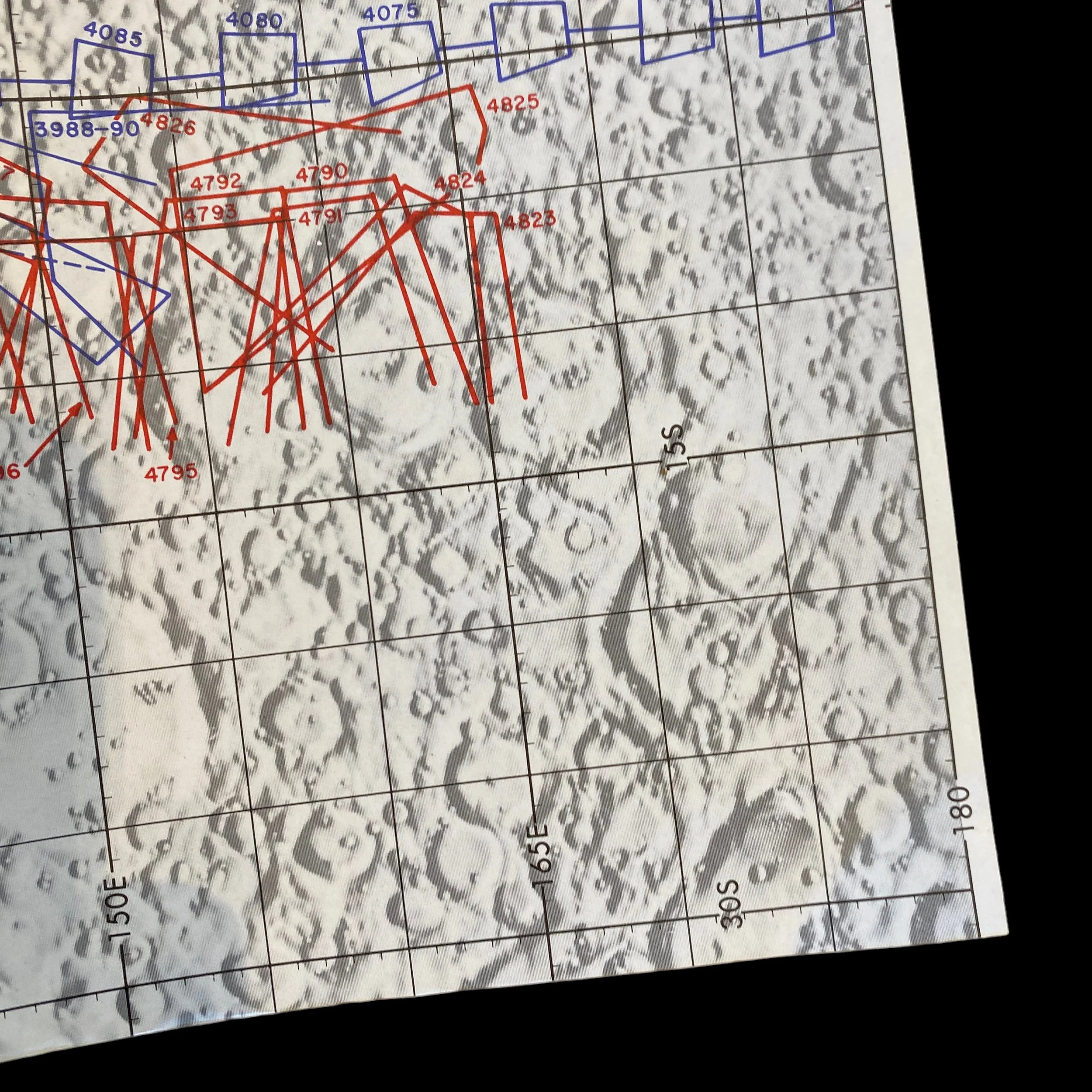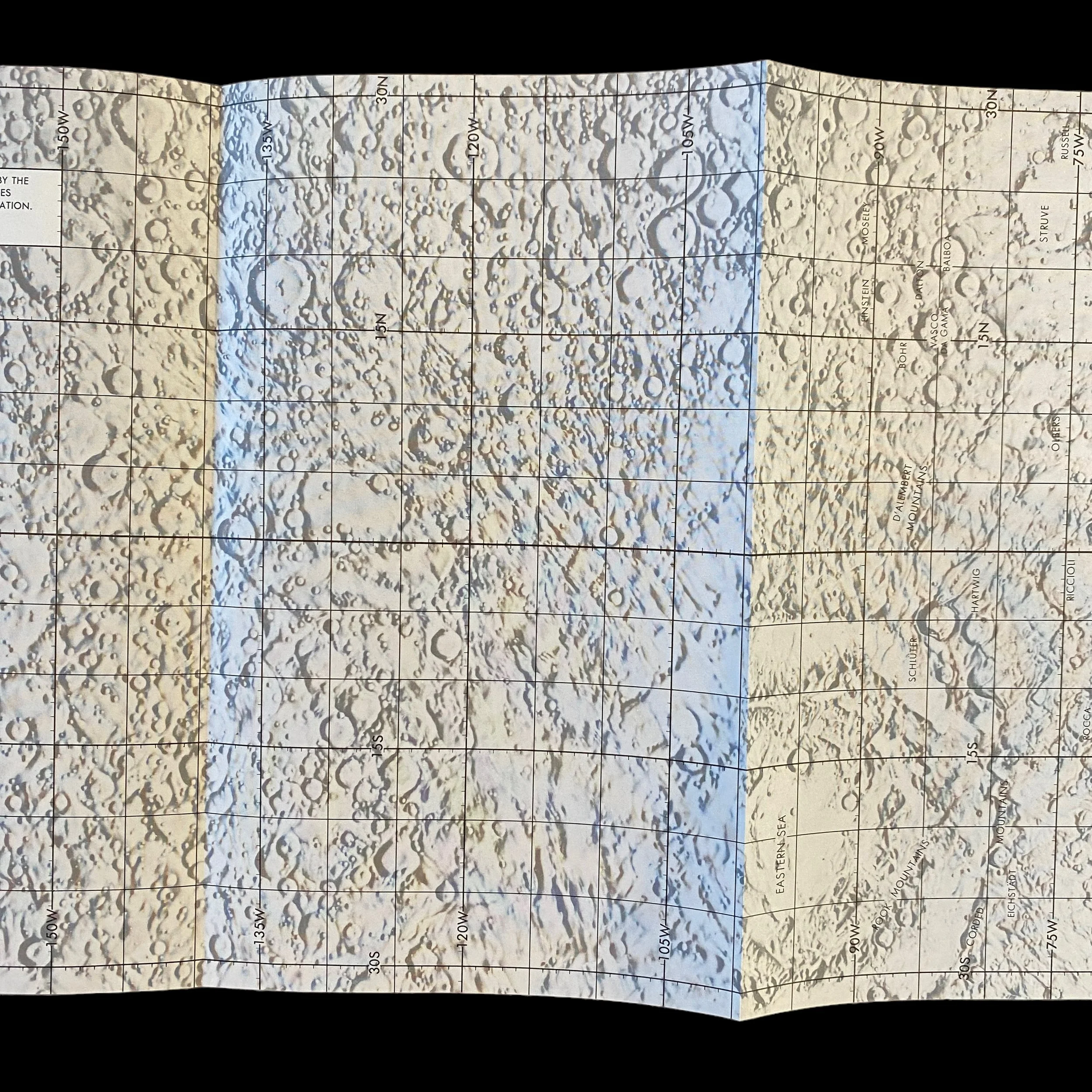Original NASA 1st Edition July 1969 Apollo 10 Lunar Photography Map*


























Original NASA 1st Edition July 1969 Apollo 10 Lunar Photography Map*
Comes with hand-signed C.O.A.
This incredible and museum-grade Apollo 10 artifact is an original “APOLLO MISSION 10 LUNAR PHOTOGRAPHY INDEX MAP”. During the Apollo 10 mission, the crew carried two 70MM Hasselblad cameras and returned with 9 magazines of film. A total of 1442 exposures were taken during the mission with 1436 useable images: 1021 on black & white film and 415 on color film. This Apollo 10 lunar chart details the exact flight path of Apollo 10 as well as the exact locations of the photographs based on their angle and view of from the Apollo 10 capsule.
Apollo 10 was the fourth manned mission in the Apollo program and the second to orbit the Moon. It was launched on May 18, 1969, and lasted for eight days. The mission was a dress rehearsal for the Apollo 11 landing, which was scheduled to take place just two months later. One of the most important aspects of the Apollo 10 mission was the lunar photography that it took. These photographs had a significant impact on lunar exploration and the success of the Apollo 11 landing.
The Apollo 10 mission was crewed by Commander Thomas P. Stafford, Command Module Pilot John W. Young, and Lunar Module Pilot Eugene A. Cernan. The mission had several objectives, including testing the Lunar Module (LM) in lunar orbit, evaluating the performance of the Command/Service Module (CSM), and performing a dress rehearsal for the Apollo 11 landing. One of the key components of the mission was the photography that it took of the lunar surface.
The Apollo 10 mission took over 4,000 photographs of the Moon's surface. These photographs were taken by both the Lunar Module and the Command/Service Module. The Lunar Module carried a 70mm Hasselblad camera, while the Command/Service Module had two cameras: a 70mm Hasselblad and a 16mm Maurer motion picture camera.
The lunar photography taken by Apollo 10 had a significant impact on lunar exploration. The photographs provided scientists and engineers with detailed information about the Moon's surface, including its topography, geology, and composition. This information was used to plan future missions to the Moon and to select landing sites for the Apollo missions.
One of the most important aspects of the Apollo 10 photography was its impact on the Apollo 11 landing. The photographs taken by Apollo 10 provided the Apollo 11 mission planners with valuable information about potential landing sites. The Apollo 10 photography revealed that the planned Apollo 11 landing site, the Sea of Tranquility, was relatively flat and free of large boulders and craters. This made it an ideal landing site for the lunar module.
The Apollo 10 photography also provided valuable information about the Moon's regolith, or lunar soil. The regolith was found to be much deeper than expected, which had important implications for the design of the Lunar Module's landing gear. The photographs also revealed the presence of a fine layer of dust on the surface of the Moon, which had to be taken into account in the design of the Lunar Module's rocket engines.
In addition to its scientific and engineering importance, the Apollo 10 photography also had a cultural impact. The photographs captured the imagination of people around the world, who were fascinated by the beauty and mystery of the Moon. The photographs were widely published in newspapers and magazines and were even featured in a special issue of National Geographic.
In conclusion, the lunar photography taken by the Apollo 10 mission had a significant impact on lunar exploration and the success of the Apollo 11 landing. The photographs provided valuable information about the Moon's surface, which was used to plan future missions and select landing sites. The photographs also captured the imagination of people around the world and helped to inspire a generation of scientists and engineers. The Apollo 10 mission remains an important milestone in the history of space exploration, and its lunar photography continues to be studied and appreciated to this day.
Apollo 10:
Apollo 10 (May 18–26, 1969) was a human spaceflight, the fourth crewed mission in the United States Apollo program, and the second (after Apollo 8) to orbit the Moon. NASA described it as a "dress rehearsal" for the first Moon landing, and designated it an "F" mission, intended to test all spacecraft components and procedures short of actual descent and landing. While astronaut John Young remained in the Command and Service Module (CSM) orbiting the Moon, astronauts Thomas Stafford and Gene Cernan flew the Apollo Lunar Module (LM) to within 15.6 kilometers (8.4 nmi) of the lunar surface, the point at which powered descent for landing would begin on a landing mission, before rejoining Young in the CSM. After orbiting the Moon 31 times, Apollo 10 returned safely to Earth; its success enabled the first crewed landing during Apollo 11 two months later.
While NASA had considered attempting the first crewed lunar landing on Apollo 10, mission planners ultimately decided that it would be prudent to have a practice flight to hone the procedures and techniques. The crew encountered some issues during the course of the flight, namely pogo oscillations during the launch phase and a brief, uncontrolled tumble of the LM ascent stage in lunar orbit during its solo flight; however, the major mission objectives were accomplished. Stafford and Cernan observed and photographed Apollo 11's planned landing site in the Sea of Tranquility. Apollo 10 spent approximately 61 hours orbiting the Moon, for about eight of which Stafford and Cernan flew the LM apart from Young in the CSM, and about 8 days total in space. Additionally, Apollo 10 set the record for the highest speed attained by a crewed vehicle: 39,897 km/h (11.08 km/s or 24,791 mph) on May 26, 1969, during the return from the Moon.
The mission's call signs were the names of the Peanuts characters Charlie Brown for the CSM and Snoopy for the LM, who became Apollo 10's semi-official mascots. Peanuts creator Charles Schulz also drew mission-related artwork for NASA.